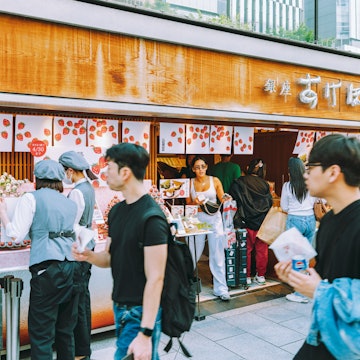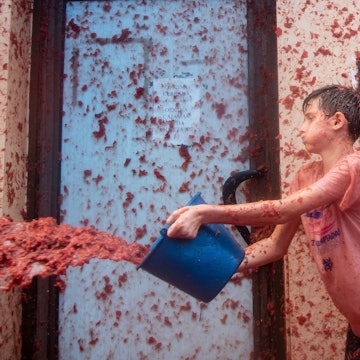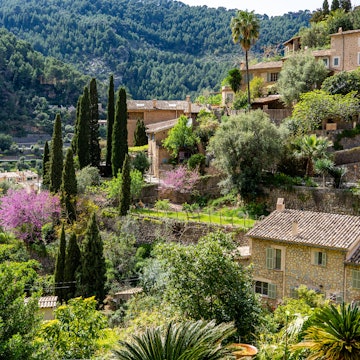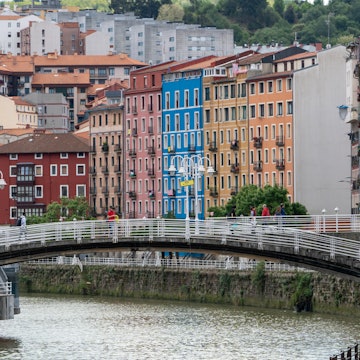
Valencia's secret history: executions and bullfights in Plaza del Mercado

Jan 9, 2024 • 7 min read

Get to know the gruesome history of Valencia's market square © pawel.gaul / Getty Images
It was a hot summer's day in Valencia when Margarida Borrás was hanged.
Despite the heat, people packed into Plaza del Mercado to watch the transgender woman expire in the gallows. Public hangings were meant to be a deterrent, but for the general public of the 15th century, they were entertainment; a big, rowdy spectacle – a bit like a modern-day soccer match.
Looking at the square today it's hard to imagine. Lined by elegant houses with jaunty balconies, it's filled with a jumble of visitors taking selfies and abuelas (grandmothers) nipping through with shopping trollies. They're all en route to Mercado Central, a grand market and one of the city's most-loved tourist attractions. Plaza del Mercado looks like a joyful place – and it is – but the square's pretty facade belies a grisly history.
The bench beneath the palm tree, where holidaymakers sit and graze on bocadillos de jamón (ham sandwiches), is roughly where the executions took place. In the Middle Ages, Valencia's market was an improvised, ramshackle event outside the old city walls. Traders would pitch up on homemade stalls, and shoppers would have to navigate bickering live animals and haggling farmers. As Valencia grew, the market was gradually enveloped by the city and became the hub of the community. The square hosted everything from festivals to funerals, protests to parades, and from the end of the 14th century, public hangings.

The tragic death of a trans icon
The gallows were a huge part of day-to-day life: they were plonked right next to the main market in the busiest square in Valencia and there was no avoiding them. In 1601, more than one person was hanged per month – and they were left in the gallows for days after they died. So even if you walked around the block to avoid the horrific sight of a bloated corpse one week, then next week you might hear the trumpets declaring the next victim as the executioner rallied up the crowd like a sinister street performer.
Plaza del Mercado wasn't the only place where public executions took place: caballeros, or noblemen, were killed near Catedral de Valencia, and heretics in Paseo de la Pechina. In Plaza del Mercado it was a little of everything: murderers, thieves and people accused of sodomy. And although hanging made up the majority of executions, there were a few recorded cases of decapitation, garroting and being burned at the stake.
Among the thousands executed in Plaza del Mercado, one of the most tragic stories follows Margarida Borrás in the 15th century. Daughter of a wealthy official from Mallorca, Borrás was a socialite who mingled with the city's elite. Margarida was born a male, named Miquel, but she openly lived her life as a woman, and this was the reason her life was tragically cut short.
Margarida was imprisoned and tortured after being found in people's houses in women's clothing, according to notes kept by Melcior Miralles, who helped with the execution. She was hanged on July 28, 1460. Miralles writes that on the day she was hanged she was forced to dress in a man's shirt and nothing else, so that the world could see “les vergonyes,” or “the shame.” A number of men were tortured in relation to the case, but their identity and fate remains a mystery. Some people have guessed that they were Margarida's former partners.
Margarida has since turned into an icon for trans rights. In 2017 a memorial plaque was mounted in her honor, and in the name of anyone who has had to fight against transphobia. Find it on Mercado Central, on the wall opposite La Lonja de la Seda. Speaking at the time, former mayor Joan Ribó said it was one of the most “cruel and degrading” incidents in the city's history, and that this plaque symbolizes their mission to make Valencia a “city free of hate.”

The last known execution of the Spanish Inquisition
Another impactful story is the last death ordered by the Spanish Inquisition. Essentially, the Spanish Inquisition was a period when the Catholic Church sought to stamp out heresy, which it attempted to achieve through brutal interrogation and public executions. Anyone could report heresy to the church, and sentencing would often end in the accused being tortured, hanged or burned at the stake.
Cayetano Ripoll worked as a teacher in Russafa. One day, an anonymous woman noticed that he didn't take his students to mass. She also noted that when students entered his class he asked them to say “praise God” instead of “hail Mary.” It was enough for her to formally denounce Ripoll for heresy and he was arrested in 1824.
On July 31, 1826, Ripoll was hanged in Plaza del Mercado, writes Rosario Cruz Garcia Peris in La Plaza del Mercado de València. The official punishment was to be burned at the stake, but in the mid-19th century they couldn't quite bring themselves to carry out the sentence in all its brutality. Instead they painted demons and flames on the gallows to emulate the cruel form of execution.
A lion and a bull fight to the death
Executions weren't the only gruesome spectacle in Plaza del Mercado. Fatal bullfights were also held here, filling the streets with wild crowds and blood. The wrought-iron balconies that line the square were the best seats in the house, and would have been reserved for royalty and high flyers. Streets were fenced off and bulls were encouraged to run by stabbing them with a long cane with a nail in it. The matador attempted to kill the creature on horseback, and would eventually go on foot to finish them off, writes Peris.
In 1459, King Juan II hosted a huge two-day bullfighting festival in Plaza del Mercado, wrote Melcior Miralles contemporaneously. The main event was a fight to the death between a lion and a bull, which took place on the second day. But according to Miralles, the animals didn't want to engage and so they forced a Jew to enter the cage and poke the feline and encourage it to fight. The diary doesn't go on to say what happened and we can only imagine how that gory game ended.
Join a tour of Valencia's secrets and legends
These disturbing scenes are a total clash with modern day Plaza del Mercado, but that doesn't mean visitors can't dip into the square's murky past. There are buckets of history tours that take place around the city, and the night walk hosted by tourism board Visit Valencia delivers frightening facts and ancient mysteries. Secrets and Legends under the Moon of València costs €15 and takes place on Saturday evenings.
Elsewhere, history fans meet at dusk by a Gothic doorway in Plaza de la Virgen to embark on the Valencia Macabra tour by Spain Free Tours. The tour traverses winding atmospheric streets to Plaza del Mercado, where the guide dives into the history of public executions and how they left their mark on the city today.

Explore one of Plaza del Mercado's oldest, grandest buildings
Built between 1482 and 1533, the city's silk market La Lonja de la Seda overlooks the square and has been a silent witness to some of Valencia's goriest events. The building was declared a UNESCO World Heritage Site in 1996 for being a late-Gothic architectural marvel and a symbol of the power and wealth of Valencia in its Golden Age of commerce. Entry is €2 and we recommend the audio guide (€2.50), which is fascinating and to the point. It even includes secret bonus tracks for proper history geeks.
Find more fascinating facts in fairy-tale bookshops
Want to plunge deeper into the past? There is no better place for fascinating facts than a bookshop, and Valencia has some picture-perfect stores to get lost in. Librería Anticuaria Rafael Solaz is hidden down a narrow pedestrianized street opposite Mercado Central. Find old wooden shelves that cling to the ceiling, stuffed with leather-bound beauties with delicate gold lettering and antique city guides. The books are carefully curated by Rafa; he's usually found in the back sifting through boxes of old letters and vintage photographs.
Further afield, Libreria Regolf specializes in topography, travel writing and outdoor guides, and its local history section is full of excellent niche titles. Particularly good is 1001 Curiosidades de la Historia de Valencia by Salvador Raga Navarro, which dishes up tasty little facts that are fun and easy to read.















